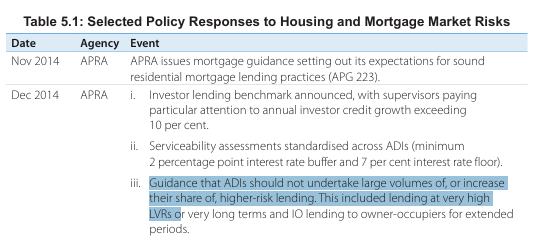The Australian Prudential Regulatory Authority (APRA) has consistently flagged high loan-to-valuation ratio (LVR) mortgage lending as a risk area.
For example, in December 2014, the Australian Prudential Regulatory Authority (APRA) released guidance stating that “ADIs should not undertake large volumes of, or increase their share of, higher-risk lending. This included lending at very high LVRs”:

In its June 2025 APG 223 Residential Mortgage Lending Update, APRA explicitly warned of risks inherent with LVR lending above 90%:
APRA has not formally defined ‘high LVR lending’, but experience shows that LVRs above 90% (including capitalised LMI premium or other fees) clearly expose an ADI to a higher risk of loss…
Although mortgage lending risk cannot be fully mitigated through conservative LVRs, prudent LVR limits help to minimise the risk that the property serving as collateral will be insufficient to cover any repayment shortfall.
Consequently, prudent LVR limits serve as an important element of portfolio risk management…
The Reserve Bank of Australia (RBA) has also highlighted the risks of high-LVR lending, noting that borrowers in these categories are more likely to experience mortgage stress and default, especially during economic downturns:
Borrowers with high-LVR loans may also be more likely to face repayment difficulties in the event of a shock because their lower levels of equity mean they are less able to avoid such difficulties by selling their property or refinancing their loan.
A loan with a higher initial LVR is also more likely to lead to larger losses for lenders in the event of default, as the loan is more likely to be in negative equity at the point the property is actually sold (for a given rate of amortisation and housing price growth).
With this background in mind, it is disturbing that the Albanese government has sought to institutionalise 95% LVR lending via its 5% deposit scheme for first home buyers.
Analysis by the Parliamentary Library on behalf of the Greens suggests that the majority of people who will be eligible for the low-deposit scheme would not be able to afford mortgage repayments on the median home without falling into housing stress.
Greens senator Barbara Pocock says first-home buyers with a mortgage debt of 95% would have weekly mortgage repayments of more than $1,000, adding that it is reckless to push people into loans they cannot afford.
“This isn’t a housing fix. It ignores the real causes of the housing crisis. We should cut tax breaks for wealthy property investors and build affordable and social housing”, she said.
Any ‘benefits’ from this policy will evaporate once the extra buyer demand from the scheme is capitalised into higher home prices.
Fast forward a few years, and prices will have surged higher, and future first-home buyers will enter a market that is significantly more expensive than it would have been otherwise. They will be purchasing with smaller deposits and carrying far larger mortgages than they would have otherwise.
These buyers will also face the prospect of falling into negative equity if there is a significant decline in home prices.
Taxpayers will also be on the hook to cover any losses resulting from mortgage defaults, given the government will guarantee 15% of all first-home buyer mortgages under the scheme.
In short, the federal government has ignored regulator warnings about high LVR mortgages, thrown caution to the wind, and attempted to socialise the housing bubble.

